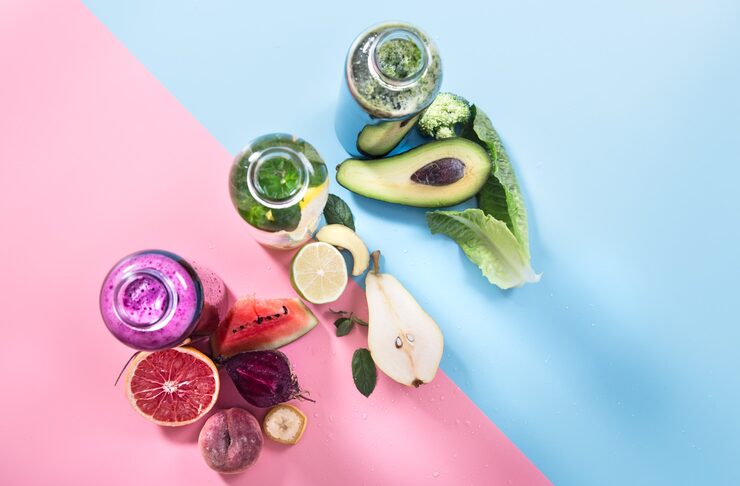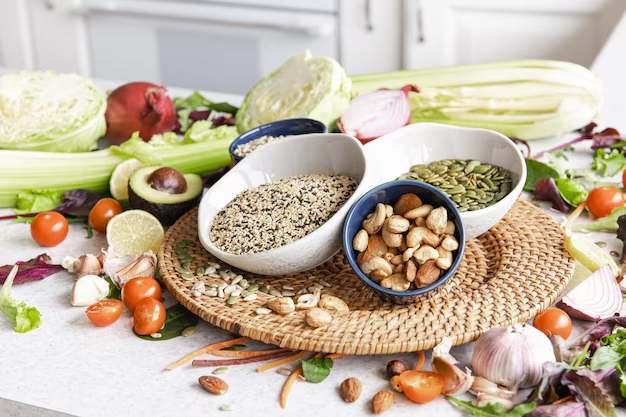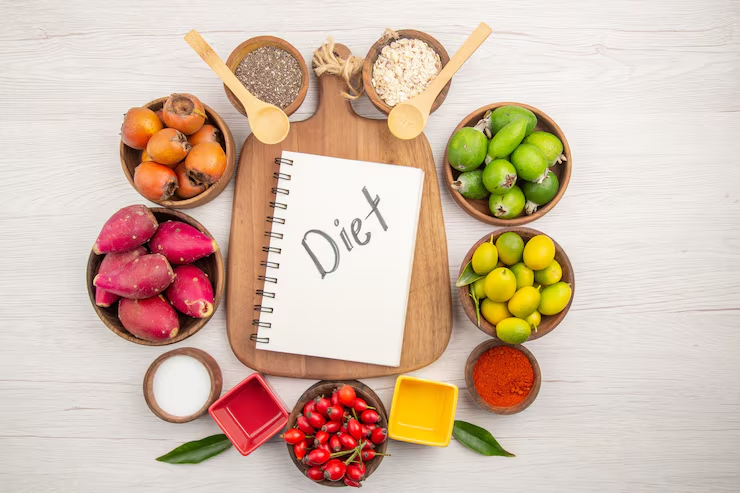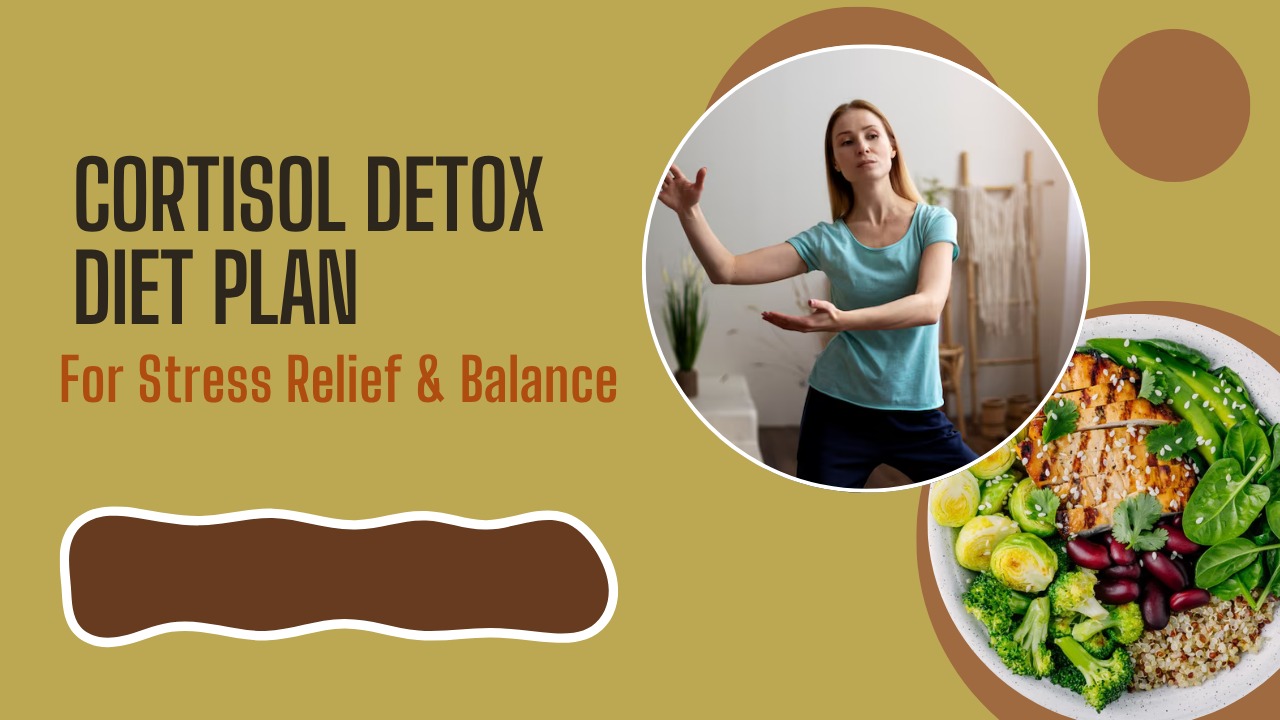Cortisol is a vital hormone produced by your adrenal glands, playing a key role in metabolism, blood pressure regulation, and immune function. It follows a natural rhythm—higher in the morning to help you wake up and lower at night to promote restful sleep. In short bursts, cortisol is helpful and even necessary.
However, when stress becomes chronic or your lifestyle lacks balance, cortisol levels can remain consistently elevated. This leads to fatigue, weight gain (especially around the belly), disrupted sleep, and even a weakened immune system. That’s where a well-structured cortisol detox diet plan comes in.
A cortisol detox diet plan focuses on foods that reduce inflammation, regulate blood sugar, and support adrenal function. It emphasizes whole foods, lean proteins, healthy fats, and magnesium-rich vegetables. Paired with adequate hydration, mindful eating, and better sleep, this plan helps reset your body’s natural stress response and restore hormonal balance.
A Cortisol Detox Diet Plan aims to reset your cortisol levels naturally—reducing chronic stress, improving metabolism, supporting adrenal health, and ultimately bringing the body back into balance. It’s not just a diet; it’s a lifestyle approach focusing on food, stress management, sleep, and hydration.

What Causes Elevated Cortisol ?
Cortisol, the body’s primary stress hormone, is meant to rise temporarily in response to danger or pressure. However, when daily stressors become chronic—like work deadlines, lack of sleep, emotional strain, or poor diet—cortisol levels can remain elevated. Over time, this disrupts metabolism, weakens immunity, and impacts mood and memory.
Other triggers of high cortisol include overconsumption of caffeine, intense workouts without proper recovery, and imbalanced blood sugar levels. Skipping meals or relying on processed foods can also spike cortisol. If left unchecked, these factors lead to a vicious cycle of fatigue, weight gain, and anxiety.
A cortisol detox diet plan is designed to address these root causes by introducing nutrient-dense foods, supporting adrenal health, and encouraging a calmer daily rhythm. By reducing triggers and fueling the body with balanced meals and proper rest, you can naturally lower cortisol levels and restore both mental and physical well-being.
Cortisol production increases during stress. This is part of the “fight or flight” response. However, your body can’t distinguish between real danger and modern-day stressors like:
Work deadlines
Financial worries
Overexercising
Sleep deprivation
Refined sugar intake
Caffeine overuse
When stress becomes chronic, cortisol levels stay elevated, leading to symptoms like:
Weight gain (especially belly fat)
Fatigue
Mood swings
Anxiety and depression
Brain fog
Insomnia
Sugar cravings
Hormonal imbalances
This is where a cortisol detox diet plan comes in, helping to recalibrate your internal balance.
Why and When Should You Do a Cortisol Detox ?
Modern life constantly exposes us to stress—from demanding jobs to digital overload—which can lead to chronically high cortisol levels. Elevated cortisol may cause weight gain, fatigue, poor sleep, anxiety, and weakened immunity. This is why adopting a cortisol detox diet plan is essential for long-term wellness and hormonal balance.
The best time to begin a cortisol detox is when you notice persistent symptoms like brain fog, irritability, belly fat, or irregular sleep patterns. These are your body’s signals that your stress response system is overloaded. Starting a cortisol detox diet plan early helps prevent more serious health issues down the line.
A cortisol detox diet plan works to reset your internal rhythm by reducing inflammation, stabilizing blood sugar, and improving nutrient intake. It’s not about drastic change—it’s a mindful shift toward healing and balance. When you prioritize your body’s stress response, everything from your energy to your mood improves naturally.
You should consider a cortisol detox if you:
Experience constant fatigue even after sleeping
Struggle with anxiety or irritability
Have difficulty losing weight despite exercise
Wake up feeling wired or can’t fall asleep at night
Have frequent sugar cravings or crashes
Doing a cortisol detox for 2 to 4 weeks can dramatically lower inflammation, enhance mood, improve digestion, and revitalize energy.
How Does a Cortisol Detox Diet Work ?
A cortisol detox diet plan works by targeting the root causes of elevated cortisol—chronic stress, poor nutrition, and disrupted sleep patterns. It aims to lower inflammation, balance blood sugar, and support the adrenal glands, which are responsible for cortisol production. The goal isn’t to eliminate cortisol completely, but to bring it back to healthy, functional levels.
This plan emphasizes nutrient-dense foods such as leafy greens, healthy fats, clean proteins, and complex carbohydrates while eliminating refined sugars, processed foods, and stimulants like caffeine. It also includes hydration, adaptogenic herbs, and mindful eating practices to naturally regulate stress hormones.
Over time, following a cortisol detox diet plan helps reset your body’s internal clock, stabilizes mood swings, improves digestion, enhances sleep quality, and reduces fatigue. It’s a gentle, holistic approach to hormone balance that doesn’t rely on extreme restriction but focuses on nourishing the body and calming the nervous system.
The cortisol detox diet works by:
Regulating Blood Sugar – to prevent cortisol spikes
Reducing Inflammation – to calm adrenal stress
Balancing Hormones – by supporting the endocrine system
Nourishing the Gut – since gut health affects mood and stress
Supporting the Nervous System – to bring calm and reduce reactivity
This plan focuses on whole foods, low-glycemic meals, adaptogenic herbs, hydration, quality sleep, and stress-reducing practices like yoga or breathwork.
Top Cortisol Detox Diet Tips
Eat a Blood Sugar-Balancing Breakfast Within 60 Minutes of Waking

A foundational step in a successful cortisol detox diet plan is eating a balanced breakfast within 60 minutes of waking. This early nourishment helps stabilize blood sugar levels, signals safety to your nervous system, and prevents a cortisol spike, which naturally occurs in the morning to help you wake up.
Your breakfast should include a mix of protein, healthy fats, and complex carbohydrates. Think scrambled eggs with avocado and sautéed greens, or Greek yogurt with chia seeds and berries. These combinations not only support hormone balance but also help maintain steady energy and focus throughout the day.
Skipping breakfast or relying on sugar-laden options can trigger blood sugar crashes, increasing stress and cortisol output. By making this habit a part of your cortisol detox diet plan, you’re setting the tone for balanced hormones, reduced anxiety, and better mood regulation from the very start of your day.
Why it helps: Skipping breakfast or eating sugary cereals can spike cortisol. Eating a protein-rich meal early stabilizes blood sugar and reduces morning stress.
Suggested Ingredients:
Organic eggs
Avocados
Spinach
Whole grain toast
Chia seeds or flaxseed
Benefits:
Sustained energy
Reduced morning anxiety
Improved focus and cognition
Incorporate Adaptogenic Herbs Daily
A key element of a successful cortisol detox diet plan is the inclusion of adaptogenic herbs. These natural remedies help your body adapt to stress and rebalance cortisol levels without the side effects of pharmaceuticals. Popular adaptogens like ashwagandha, rhodiola, holy basil, and maca root have been used for centuries to support adrenal function and promote calm energy.
Incorporating these herbs into your daily routine can be simple. You can add ashwagandha powder to smoothies, sip on tulsi (holy basil) tea during your afternoon break, or take rhodiola in capsule form before mentally demanding tasks. Over time, these herbs help regulate your body’s stress response and reduce cortisol spikes.
Adding adaptogens to your cortisol detox diet plan offers a natural, gentle way to nourish the nervous system. Combined with healthy food choices, hydration, and rest, these herbs act as powerful allies in your journey to restore balance and vitality.
Why it helps: Adaptogens help your body adapt to stress by regulating cortisol production and supporting adrenal function.
Top Adaptogens:
Ashwagandha
Rhodiola
Holy basil (Tulsi)
Maca root
How to use:
In smoothies, teas, or capsules
Example: Tulsi tea in the morning
Benefits:
Lowers anxiety
Increases stamina
Balances hormones
Avoid Refined Sugar and Processed Foods
One of the most crucial steps in any effective cortisol detox diet plan is eliminating refined sugar and processed foods. These ingredients spike blood sugar, which in turn triggers a surge in cortisol—a response meant to stabilize your energy but harmful when repeated often. Over time, this cycle can lead to adrenal fatigue, mood swings, and weight gain.
Processed foods are also often loaded with preservatives, unhealthy fats, and hidden sodium, all of which place unnecessary stress on your digestive and endocrine systems. Choosing whole, unprocessed foods helps stabilize blood sugar levels and reduce inflammation, creating a foundation for hormonal balance.
Incorporating real, nutrient-rich foods like leafy greens, berries, whole grains, and lean proteins ensures your cortisol detox diet plan works synergistically to support both body and mind. By cutting out refined sugars and processed meals, you’re making a conscious move toward long-term wellness and adrenal support.
Why it helps: These foods trigger insulin spikes, leading to cortisol release. Sugar also feeds gut bacteria imbalance, contributing to mental stress.
Ingredients to Avoid:
Soda, pastries, candy
White bread, instant noodles
Fried foods, artificial additives
Benefits:
Reduces cortisol spikes
Promotes mental clarity
Supports gut health
Practice Intermittent Fasting Wisely (12:12 or 14:10)
Intermittent fasting can be a powerful tool when included thoughtfully in a cortisol detox diet plan. The key is to avoid extreme fasting windows that may elevate stress hormones. Gentle approaches like 12:12 (12 hours of fasting, 12 hours of eating) or 14:10 are ideal for supporting circadian rhythm without triggering adrenal overload.
These fasting windows allow the body to rest and repair while still ensuring steady blood sugar levels. During the eating window, focus on nutrient-dense, whole foods rich in healthy fats, lean proteins, and fiber. This stabilizes insulin and keeps cortisol fluctuations in check throughout the day.
As part of a well-structured cortisol detox diet plan, wise intermittent fasting supports metabolic health, reduces inflammation, and enhances energy levels. Always listen to your body—if fasting feels overly stressful, adjust your schedule. The goal is hormonal balance and resilience, not deprivation or burnout.
Why it helps: Gentle intermittent fasting can reset insulin and cortisol rhythms, but overdoing it can backfire.
How to do it:
Eat within a 10–12 hour window
Avoid fasting longer than 14 hours if you’re stressed
Benefits:
Balances blood sugar
Improves digestion
Enhances sleep
Hydrate With Electrolyte-Rich Fluids

Hydration plays a vital role in balancing cortisol levels and supporting adrenal function. A well-designed cortisol detox diet plan emphasizes not just water, but also fluids rich in essential electrolytes like magnesium, potassium, and sodium. These minerals help regulate nerve and muscle function, promote energy production, and support stress recovery.
Start your day with warm lemon water and a pinch of Himalayan salt to kickstart your system and restore morning hydration. Throughout the day, incorporate drinks such as coconut water, herbal teas, or homemade electrolyte blends with sea salt and citrus. These options are more effective than plain water alone at replenishing what your body loses through stress and sweat.
When following a cortisol detox diet plan, staying well-hydrated helps flush out toxins, improve mental clarity, and maintain optimal hormonal balance. Prioritizing hydration is a simple yet powerful step toward restoring calm and building long-term stress resilience.
Why it helps: Dehydration increases cortisol. Drinking water infused with natural minerals calms the adrenal glands.
Ingredients:
Coconut water
Himalayan salt (a pinch in lemon water)
Cucumber-mint infused water
Benefits:
Restores energy
Regulates blood pressure
Reduces sugar cravings
Prioritize Sleep Hygiene
Prioritizing sleep hygiene is a key pillar of any effective cortisol detox diet plan. Cortisol levels naturally fluctuate throughout the day, peaking in the morning and tapering off at night. Poor sleep can disrupt this rhythm, causing cortisol to stay elevated and making it harder for your body to recover and reset.
To support your body’s natural detox processes, aim for 7–9 hours of uninterrupted sleep each night. Establish a calming nighttime routine that includes limiting screen time, dimming lights, and avoiding caffeine after mid-afternoon. Incorporating herbal teas like chamomile or lavender and practicing relaxation techniques such as deep breathing or meditation can also prepare your mind and body for restful sleep.
When combined with a nutrient-rich cortisol detox diet plan, consistent sleep can help regulate hormone levels, reduce stress, and restore adrenal balance. Quality rest isn’t a luxury—it’s a necessity for long-term vitality and resilience.
Why it helps: Poor sleep increases cortisol. Consistent, quality sleep is essential for hormone balance.
Sleep Hygiene Tips:
Avoid screens 1 hour before bed
Take magnesium glycinate or lavender tea
Keep bedroom dark and cool
Benefits:
Reduces anxiety
Boosts metabolism
Improves memory and mood
Eat Cortisol-Lowering Superfoods

One of the most powerful strategies in a cortisol detox diet plan is to incorporate foods that naturally help regulate stress hormones. Certain nutrient-dense superfoods can actively support adrenal health and reduce inflammation. Leafy greens, fatty fish like salmon, berries, and avocados are all rich in antioxidants, healthy fats, and essential vitamins that help modulate cortisol levels.
Magnesium-rich foods such as pumpkin seeds, bananas, and dark chocolate play a vital role in calming the nervous system and improving sleep—two key factors in controlling cortisol. Additionally, adaptogenic herbs like ashwagandha and holy basil can be consumed as teas or supplements to help your body adapt to stress more efficiently.
By prioritizing these superfoods in your cortisol detox diet plan, you give your body the tools it needs to naturally rebalance. Over time, this can lead to improved energy, reduced anxiety, and a stronger resilience to daily stressors.
Why it helps: Certain foods are scientifically shown to lower stress hormones.
Top Cortisol-Lowering Foods:
Fatty fish (salmon, mackerel)
Dark leafy greens
Blueberries
Turmeric
Dark chocolate (min 70%)
Fermented foods (kimchi, sauerkraut)
Benefits:
Fights inflammation
Supports mental health
Improves digestion
Mind-Body Practices: Daily Movement & Meditation
A successful cortisol detox diet plan isn’t just about what you eat—it’s also about how you move and calm your mind. Regular physical activity, such as walking, yoga, or stretching, plays a crucial role in lowering elevated cortisol levels. Gentle movement stimulates circulation, supports digestion, and helps the body release built-up tension.
Incorporating daily meditation or deep breathing practices enhances the effects of your cortisol detox efforts. Just 10–15 minutes of mindfulness, breathwork, or gratitude journaling can shift your body from a stress response to a state of relaxation. This allows your nervous system to reset and encourages hormonal balance.
Pairing your cortisol detox diet plan with consistent mind-body practices creates a foundation for true healing. By honoring both your physical and emotional needs, you’ll not only manage cortisol more effectively but also experience improved focus, better sleep, and a renewed sense of calm and vitality each day.
Why it helps: Exercise reduces cortisol—but overexercising can increase it. Gentle movement and mindfulness practices are most effective.
Activities to Try:
Walking in nature
Yoga or Pilates
Breathwork
Guided meditation
Benefits:
Balances the nervous system
Increases serotonin and dopamine
Enhances sleep and focus
Sample Daily Cortisol Detox Diet Plan
Here is your cortisol detox diet plan in a clear table format:
| Time | Meal/Drink |
|---|---|
| Morning (7–9 AM) | – Warm lemon water with Himalayan salt- Scrambled eggs with spinach & avocado- Tulsi tea |
| Mid-Morning Snack (10:30 AM) | – Chia pudding with berries |
| Lunch (1 PM) | – Grilled salmon- Quinoa salad with kale, cucumber & olive oil- Kombucha or coconut water |
| Afternoon (4 PM) | – Handful of walnuts and an apple- Rhodiola tea |
| Dinner (7 PM) | – Roasted turkey or lentil stew- Steamed broccoli with turmeric & black pepper- Small square of dark chocolate (optional) |
| Before Bed (9 PM) | – Magnesium glycinate supplement- Chamomile or lavender tea- Journaling or meditation |
This cortisol detox diet plan supports adrenal health, reduces inflammation, and promotes balanced cortisol levels throughout the day.
Conclusion

A cortisol detox diet plan is not about rigid rules or depriving yourself—it’s about restoring balance and supporting your body’s natural rhythm. Chronic stress, poor sleep, and processed foods can throw off cortisol levels, but with mindful lifestyle changes, you can bring your system back into harmony.
This plan emphasizes nutrient-dense foods, consistent hydration, quality rest, and intentional stress reduction. Incorporating adaptogenic herbs, magnesium-rich foods, and anti-inflammatory meals helps calm the nervous system and support adrenal function. It’s not a crash diet—it’s a holistic reset.
The real power of a cortisol detox diet plan lies in its ability to help you feel centered again. When cortisol is balanced, energy improves, sleep deepens, and mental clarity returns. This isn’t just a diet—it’s a long-term commitment to wellness, resilience, and mindful living. Give your body the support it needs and reclaim your inner balance, one nourishing choice at a time.
FAQs
Q1. What is a cortisol detox diet plan ?
It is a strategic nutrition and lifestyle approach designed to naturally reduce elevated cortisol levels, support adrenal function, and improve energy, sleep, and weight management
Q2. How long should I follow a cortisol detox diet ?
Typically, 2–4 weeks is ideal for resetting cortisol rhythms, though some people extend it up to 8 weeks for deeper adrenal support. Listen to your body and monitor improvements.
Q3. Can I lose weight with a cortisol detox diet plan ?
Yes, many people lose weight—especially belly fat—as their body exits “fight-or-flight” mode. Balanced cortisol helps reduce sugar cravings, normalize appetite, and improve metabolism.
Q4. Are there any side effects of the cortisol detox diet ?
When done correctly, side effects are rare. However, some may initially feel tired or moody as the body adjusts. Always consult a health professional if symptoms persist.
Q5.Can I continue exercising during the cortisol detox ?
Yes, but choose gentle movement like yoga, walking, or tai chi. High-intensity training can increase cortisol if you’re already stressed.


